Record Job Openings Exceeded Only by Level of Those Not In the Labor Force
The private sector cannot delay to act in ways that will structurally support the economy in the long-term while the government temporarily props up the economy through debt spending. The hard truth is that delaying any efforts to build a bigger and smarter labor force now -which is within the ability of many of our readers to control- will result in severe consequences later. Even though many industry leaders are overwhelmed with work now, there is no time to delay in building tomorrow’s workforce.
The Wall Street Journal’s June 4th assessment of the U.S. labor market using Bureau of Labor Statistics (BLS) data found that there were 7.6 million fewer people employed at the end of May than in January of 2020, with 9.3 million people potentially available to work. One area which didn’t receive a quantitative assessment was the number of job openings which at 8.12 million is the highest number of openings in over 20 years. (Granted, one must always beware of structural unemployment issues, especially the problem of a skills available verses needed mismatch.)
It would be shortsighted to suggest that topped-up unemployment benefits did not have a place during the pandemic; however, today’s 50-year low labor force participation rate coupled with a multi-decade high in the number of unfilled job openings suggests that the labor component of the economy is in a perilous position despite the latest GDP growth figures.

The number of unfilled jobs and those not participating in the labor force have both reached multi-decade highs. This is a worrisome combination for the long-run growth of the economy.
The generous benefits provided to the employed and especially the unemployed over the last year have created an unsustainable situation for both public debt and the labor market that cannot last. Both the time and sacrifices needed to ween the economy back to real health will not be insignificant. A plan away from government stimulus needs to be developed and executed now in order for there to be a TIMELY transition of the economy towards long-run growth led by the private sector.
The unemployed and underemployed need to be developing their next skill set now. However, their success will be at least partially dependent upon business leaders diligently working to develop or expand their existing training programs AND GET THE WORD OUT. In 2018, during the peak of the last cycle, many firms had great training programs… that no one knew about. Back then the hard lesson learned was if you build it, that does NOT mean they will just magically come. Delaying such action while the government is still willing to ‘pick up the tab’ is short-sighted and will have significant consequences for the long-run success of the country.
I have little doubt that more than a few of you reading this are thinking about how overwhelmed you already are with work compounded with broken supply chains and growing backlogs (manufacturers tell me this all the time) and now you have some quant telling you to spend time you don’t have to focus on new employee development?!
The hard truth though is that delaying the creation of a bigger and smarter labor force now -which is in the ability of many of you readers to control- will have severe consequences for you and the greater economy. Without getting this situation resolved, the country will move ever closer towards a path of being excessively burdened by debt (and the higher taxes and interest rates that will result from over indebtedness) and an under-sized and under-skilled workforce that means few shoulders (including yours personally) to carry the heavy burdens of the government’s past decisions.
I believe the hard question we must face is: Would you rather build a workforce now when you at least have the financial resources to do it, or wait and train new employees who are even further behind at a time of when the economy is not growing at 6-percent or more?




.jpg;width=70;height=70;mode=crop)
